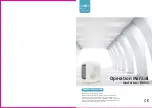
5
DANGER
- Improper connection of the equipment-
grounding conductor can result in the risk of electric
shock. Check with a qualified electrician or service
person if you are in doubt as to whether the outlet is
properly grounded. Do not modify the plug provided
with the appliance - if it will not fit the outlet, have a
proper outlet installed by a qualified electrician.
This appliance is for use on a nominal 120 volt circuit
and has a grounding plug that looks like the plug in
sketch (1)- see page 4
GROUNDING INSTRUCTIONS (CONT’D)
• Do not use appliance with damaged cords or plugs. When servicing, refer to a
qualified electrician or service person only. Use only identical replacement parts.
• Make sure your extension cord is in good condition and is the correct size for your
appliance. Table (A) shows the correct size to use depending on cord length and
nameplate ampere rating. If in doubt, use the next heavier gauge. The smaller the
gauge number, the heavier the cord. An undersized extension cord will cause a
drop in line voltage resulting in loss of power and overheating.
EXTENSION CORD GUIDELINE
• TABLE A •
MINIMUM GAUGE EXTENSION CORDS
Unit's Ampere Rating
more than
0
6
10
12
6
10
Volts
120 V
Total Length of cord in feet
25
16
16
14
12
12
14
16
16
18
18
16
14
50
100
150
AWG
not more than
A temporary adapter (D) may be used to connect this plug to a 2-pole receptacle (E) if
a properly grounded outlet is not available.
The temporary adapter should be used only until a properly grounded outlet (B) can be
installed by a qualified electrician.
The green colored rigid ear, lug, or the like (F) extending from the adapter must be
connected to a permanent ground (G) such as a properly grounded outlet box cover.
Whenever the adapter is used, it must be held in place by a metal screw.
Note: In Canada, the use of a temporary adapter is not permitted by the Canadian
Electrical Code.
F
E
G
D
2






































